Glimpses of Healing and Hope
Glimpses of Healing and Hope

November 21, 2016
By: Jane Bishop Halteman
photo by Jane Bishop Halteman
Parker J. Palmer said the following in a Facebook post about the state of many in our country this past week:
“For millions of Americans, this is a time of doubt, despair, and the pain of loss.
“I have no ‘remedy’ for this widespread suffering—and if I said I did, you’d know you were hearing from yet another con man.
“But this much I know to be true: doubt is the other side of faith, despair is the other side of hope, and the pain of loss is the other side of love.
“The words (inscribed on the photo above) come as close as I can to saying why we must learn to hold our doubt, despair, and pain—until we can reclaim our belief, our hope, our love.
“We can hasten that day by joining in the never-ending struggle for love, truth, and justice in whatever ways we’re able.
“As Wendell Berry has reminded us, big problems never have one big ‘fix.’ They yield only to a million-million human scale answers to the question, ‘Under these circumstances, what’s the right thing to do?’”
In response to Palmer's musings, one of his readers offered this Mark Nepo quote: “After all these years, I’m beginning to see that tranquility is the depth of being that holds what we think and feel, not the still point after we’ve silenced what we think and feel. Serenity is the depth of being that holds difficulty, not the resting point after we’ve ended difficulty. And peace is the depth of being that holds suffering and doubt, not the raft we climb on to avoid suffering and doubt. This leads us to joy, which is much deeper and larger than any one feeling. Happiness, fear, anxiety, contentment, doubt, regret, unworthiness, anger, despair—all these and more are the waves that rise and fall in the sea of being.”
My solo drive to PA a few days after the election allowed for many prayerful tears, brought on by election trauma and intensified by news I did not want to hear about the son of a soul friend. While visiting my parents provided a good distraction from election fallout, I kept one eye on social media where I was horrified to learn from a peace and justice compatriot that she had spotted white supremacist leaflets on her walk to work in South Bend. Eventually, becoming nearly seasick in response to “the waves that rise and fall in the sea of being,” I shifted into resource-gathering mode to work at combatting the fear and despair settling upon me for the many who have been singled out in our country as different from the majority.
I borrowed Cindy Crosby’s term “spark in the dark” from last week’s edition of Tuesdays in the Tallgrass and began watching carefully for every ember, every spark of light that might come my way in this perceived darkness. And sure enough, the sparks began flaming toward me: the evening my dad surprisingly engaged in conversation when an unexpected visitor stopped by, this delightful PBS documentary on Three Rivers Spirituality (if this video does not post, read the transcript option) by correspondent Judy Valente posted in Religion & Ethics Newsweekly, these amazing renditions of the late Leonard Cohen’s Hallelujah. YouTube is full of endless examples of upbeat music. I added this Canadian Tenors version of the Cohen favorite as another of my best-loved for listening in the midst of despair. Or this one where Oprah surprises the Canadian Tenors with an appearance by Celine Dion. Or the 12 Tenors singing You Raise Me Up. Here’s another good story that I shared a year ago; a friend resurrected it again this week…it seems consoling when the world suddenly appears to be less safe for the other than it used to be.
There were these comforting words from poet David Whyte: “The antidote to despair is not to be found in the brave attempt to cheer ourselves up with happy abstracts, but in paying a profound and courageous attention to the body and the breath, independent of our imprisoning thoughts and stories, even strangely, in paying attention to despair itself, and the way we hold it, and which we realize, was never ours to own and to hold in the first place. To see and experience despair fully in our body is to begin to see it as a necessary, seasonal visitation, and the first step in letting it have its own life, neither holding it nor moving it on before its time.” For more on Whyte’s approach to despair, see this link.
From Joan Chittister, I found these encouraging words on speaking up: “Jesus left to all of us the obligation to speak up on issues that threaten to erode our humanity. To speak out for the innocent and oppressed. To speak on, however long it takes and whatever the pressures ranged against us. To speak up when we hear around us the strategies of those who would balance the national budget by denying the hungry food stamps, and children good education, and the unemployed and underpaid decent lives, and the strangers in the land a way to become community. Our obligation is not to be like those who would secure themselves by making others insecure. Our obligation is to be like Jesus.”
Toni Morrison, talking about the artist’s task in troubled times from this week’s Brain Pickings, writes that “this is precisely the time when artists go to work. There is no time for despair, no place for self-pity, no need for silence, no room for fear. We speak, we write, we do language. That is how civilizations heal. I know the world is bruised and bleeding, and though it is important not to ignore its pain, it is also critical to refuse to succumb to its malevolence. Like failure, chaos contains information that can lead to knowledge — even wisdom. Like art.”
And finally, I discovered Sojourners’ helpful list of 10 commitments we can make during a time when minorities feel threatened, starting with going deeper in faith, lifting up truth, rejecting white nationalism, loving our neighbors, and welcoming the stranger.
A Zero Balancing/Soul Lightening Acupressure session with my body/energy-worker friend helped release built-up pain and trauma from the past as well as some of the stress of the present, while Sunday's baby shower at Kern Road eased me back toward hopeful mode as I experienced the gathered community welcome this new little one into our midst in spite of the fact that our country no longer seems as much a sanctuary as I have imagined. May we take small steps together to make our homes, our places of worship, our communities sanctuaries for the marginalized and oppressed.
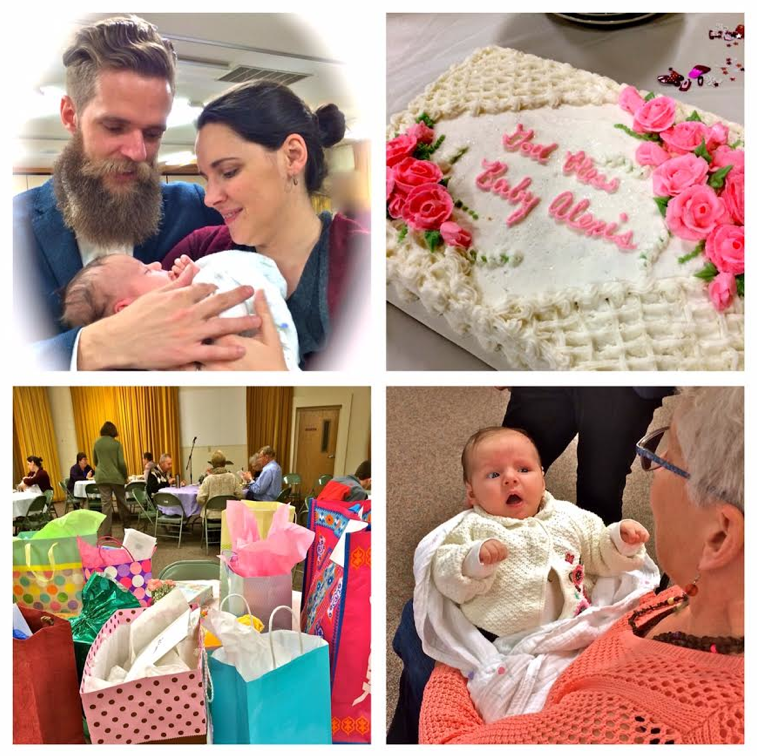
In spite of the “waves that rise and fall in the sea of being,” we celebrated the arrival of baby Alexia!
Add a comment
November 14, 2016
By: Jane Bishop Halteman
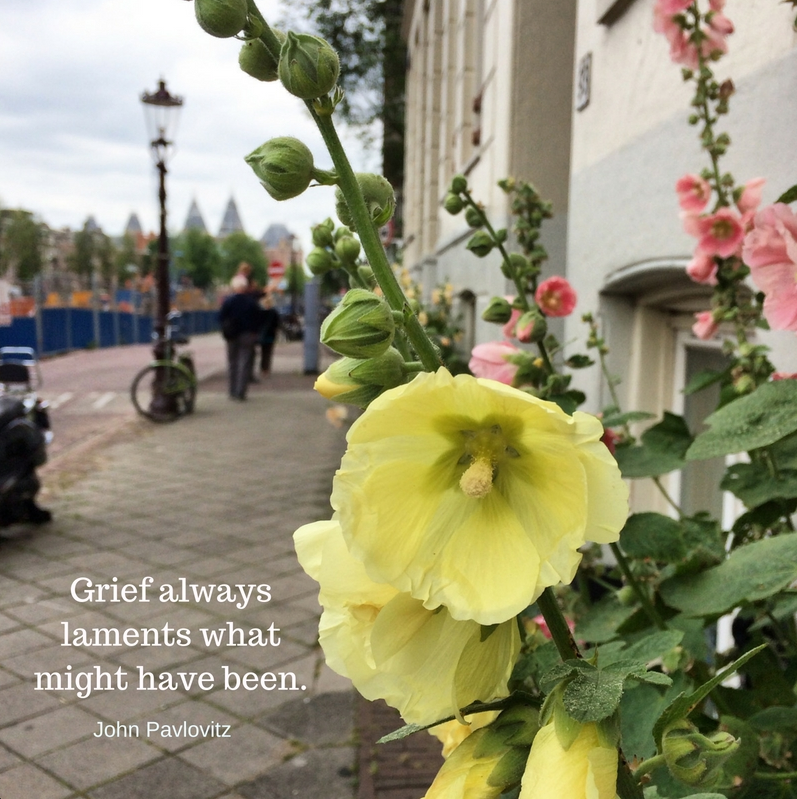
Despite whether our candidate won or lost this past week, I would be very surprised to learn that any of us feels good about negative election fallout that has surfaced since Tuesday night. My social media feed has been flooded with stories about people who fear, with what seems due cause, changes that threaten to make this country a less safe place for them as minorities.
Bernie Sanders explained it this way: the president-elect “tapped into the anger of a declining middle class that is sick and tired of establishment economics, establishment politics, and the establishment media. People are tired of working longer hours for lower wages, of seeing decent paying jobs go to China and other low-wage countries, of billionaires not paying any federal income taxes and of not being able to afford a college education for their kids—all while the very rich become much richer.”
So, yes, we see reasons why people are ready for change, but it seems to me that change which threatens the other should not be part of the new equation.
Our own daughter had this to say about her strenuous week in the classroom as a college philosophy professor: “I can’t believe how emotionally exhausting it is to teach right now. Each class today has included a litany of students’ experiences of friends who have been targeted just since the election. One student had a fight break out on her floor. Another had three friends called the ‘n word’ yesterday. Another had a friend called a ‘homo’ as he walked across a different campus yesterday. I have heard stories of undocumented students outed and threatened publicly. It goes on and on and on. To their credit, my students—including the half that voted for the president-elect—are uniformly horrified by these events and united in their fear about what the future holds. We have normalized an incredible threat to the safety and inclusivity of our communities, and now we need to figure out how to fix it. Roll up your sleeves, people, this is not going away anytime soon.”
Jonathan Merritt, writer on faith and culture, reports that “the protests on Fifth Avenue have garnered a lot of attention, but New Yorkers are posting their grief underground on tens of thousands of sticky notes. These emotional messages are slapped onto subway station walls across the city. The New York Times story on this protest is moving, but nothing beats the messages themselves,” messages offering prayers and desires for love, hope, equality, safety.
One of my friends shared a brief note about “transgender youth suicides that occurred late Tuesday night/early Wednesday morning.” And the Kissing Fish Facebook page offered this list of fearful Americans who may have reason to be involved in protests beyond whether or not their candidate lost: “They’re black Americans who hear talk of law and order and remember a racially charged stop and frisk program, or see an emboldened KKK holding a celebratory parade. They’re Muslim Americans who worry that spitting in their face is now okay and violations of their rights to assemble and their rights to privacy are about to come. They’re LGBT Americans who fear not just of the loss of marriage rights or restaurants gaining the right not to serve them, but of an administration that thinks it’s more important to research electrocuting the gay out of them than AIDS. They’re Hispanic and Latino Americans who are scared their children will be bullied in schools, and their families ripped apart while their culture is mocked. They’re women who are wondering if we’ve normalized groping, and if their career endeavors will be judged by their face and body, and not their minds.”
Many of us may feel we have no immediate access to preventing these sorts of discriminatory behaviors, but small ways of offering assistance or showing solidarity have emerged in these first few days since the election. Sojourners posted this information for what to do if you see Islamophobic harrassment. Safety Pin USA’s Facebook page tells the story of the UK’s referendum to leave the European Union, when “hundreds of thousands of British citizens took to wearing a safety pin on their lapel, a quiet and dignified gesture intended to signal to their immigrant brothers and sisters that they stood in solidarity with them against the tide of fear and hate that drove the Brexit decision. Simply put, I say that, in the wake of the US election, we repeat the practice here in the states. Too many reports have already flooded the airwaves indicating a sharp increase in racially-motivated violence and intimidation across the country, and, while this simple act may not change that, it will demonstrate to those who are the targets of such aggression in your community that they have allies on the streets, and not just the Internet.”
Already, social media has suggested that perhaps this small act of wearing a safety pin trivializes the seriousness of the situation at hand, or that wearing the pin will make us smug about doing something and less likely to work at the larger issues, or that minority groups may take offense. While I would be the last to deliberately offend, I also see that this solidarity move could be meaningful in a small way in some situations. I will not judge people for wearing the safety pin or for not wearing it. Two of my Facebook friends posted positive outcomes as they wore safety pins. One shared this safety pin story: “Yesterday in a thrift store in Normal, IL, a gray-bearded tattooed man thanked me for wearing a safety pin. We commiserated. There I have it. I talked with someone not like me in solidarity.” Another said, “I wore one yesterday and my daughter asked me why. I said it's a way of letting people who are different from me know that I'm a safe person. She was thrilled. I did not expect her to notice it or appreciate its meaning. It was worth it just for that.”
Preparation for the job ahead of us can come in all sorts of ways. My niece shared that, while cooking, she listened to an hour of Radiolab segments on laughter for much needed respite. Strangely enough, comfort food provided a sort of self-care as our family struggled to make our way through last week. I was delighted to find Trader Joe’s (in Grand Rapids) had received their holiday shipment of turkey-less stuffed roast with gravy. I bought three on Wednesday and they were gone by Friday…one with the Grand Rapids family, one with the South Bend family, and one for a late-night snack on the in-between day. Sometimes you do what you have to do to maintain sanity and a small sense of well-being in spite of the world's condition! How did you achieve that for yourself this past week?
Friday I shared our home with a peer group in the morning, a directee in the afternoon, and family members for supper. It felt good to offer warmth and hospitality to friends and family, kind of a preparation for opening myself to those I do not know who may need safe spaces in their lives, especially now. In what ways might we at Kern Road begin to reach out during this difficult post-election season to those who feel threatened? How might we provide sanctuary for the marginalized? Our faith mandates that we stand with those who are bullied because they are different. The plaque at the base of the Statue of Liberty says something very similar: “Give me your tired, your poor, your huddled masses yearning to breathe free, the wretched refuse of your teeming shore. Send these, the homeless, tempest-tossed to me, I lift my lamp beside the golden door!”
Before we can be there for others, we need personal fortification, our own resilience strategies, our own ways to work at repairing the breach, our own understanding of the grief we suffer. With regard to the latter, John Pavlovitz says this: “Grief always laments what might have been, the future we were robbed of, the tomorrow that we won’t get to see, and that is what we walk through today. As a nation we had an opportunity to affirm the beauty of our diversity this day, to choose ideas over sound bytes, to let everyone know they had a place at the table, to be the beacon of goodness and decency we imagine that we are—and we said no.
“The Scriptures say that weeping endures for a night but joy comes in the morning. We can’t see that dawn coming any time soon.
“And this is why we grieve.”
I visited an out-of-town church Sunday morning; one thing of many that I took away with me from that service was the worship leader's statement that “today is the day that we grow bigger than our differences.” I hope we can find ways to live into that sentiment. I also look forward to working with other Kern Roaders to bring Phileena Heuertz' words to fruition in our own setting: “America is not just for white Christians. America is for all people, regardless of race and creed. And regardless of what kind of government is in power, we all have a responsibility to walk the hard road of love to heal our nation.”
Add a commentNovember 7, 2016
By Jane Bishop Halteman
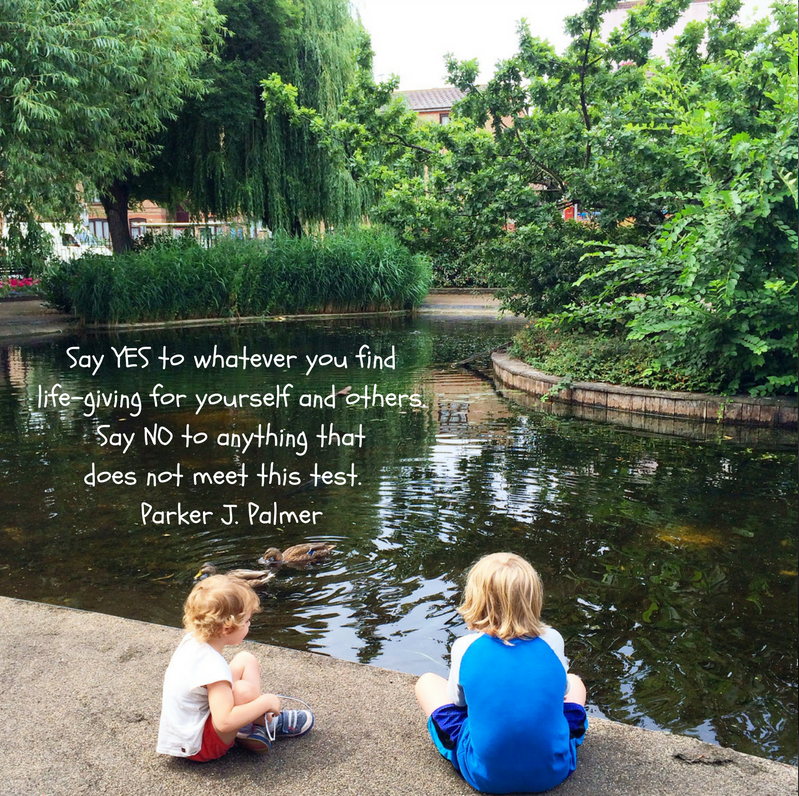
A plumb line Parker J. Palmer says he uses to test his decisions...
Laura Turner’s article, posted in the health section of The Atlantic last Tuesday, led with the headline “When National Turmoil Becomes Personal Anxiety.” The subhead read, “The hateful rhetoric and high stakes of the 2016 U.S. election are causing people emotional distress.” The article went on to state that the “election is taking a toll on everyone. The turbulence of this time of national transition can cause anxiety that makes day-to-day life more alarming, but people’s existing fears can also be inflamed by what they see happening in the election. This creates a sort of feedback loop between personal and national anxiety.”
We’re in a psychosis of what is called negative polarization, according to David Brooks’ commentary Friday on the PBS Newshour. “What’s depressed me most about this race is that we went into this a divided nation and now the chasms are solidified. We are divided along lines including race, gender, urban-rural, more and less educated. The campaign barely matters; people are just going with their gene pool,” Brooks said.
A recent Vox article headline reports that “election anxiety is real.” The article notes that preliminary data from the American Psychological Association’s (APA) upcoming annual Stress in America report reveals that about “half of people surveyed (52 percent) say the election ‘is a very or somewhat significant’ source of stress in their lives. The breakdown by party is about even: 59 percent of Republicans and 55 percent of Democrats say this election is causing them stress.” The APA also offers graphs plotting election stress by generation and race/ethnicity. Matures (71 and up) report at 59%, Boomers (52-70) at 50%, GEN Xers (38-51) at 45%, and Millennials (19-37) at 56%. The race/ethnicity graph shows these ethnicities reporting somewhat/very significant source of stress: Hispanic, 56%; White and Native American, 52%; Black, 46%, and Asian, 43%. And for women who have been physically or emotionally abused at some point in their lives, this election holds another kind of trauma.
That's a lot of people feeling tension as a result of the current election season. We know the drill about eating well, sleeping enough, getting sufficient exercise, but what else might we do to rebuild our exhausted minds and bodies after this particularly difficult cycle? Facebook friends have taken to posting beautiful music and nature photos daily as a respite to “cure their election blues,” one of them said. I’ve immersed myself in finding ways to allay election fatigue during the past weekend, the last before the 2016 presidential election. Wearied and worn by the outrageous incivility, the hurling of brutal epithets and accusations, the failure to fact-check, and the generally toxic environment that appears to have built beyond my wildest imagination in this election cycle, I polled KRMC Facebook page followers to see what they might recommend to beat election anxiety and fatigue. Catherine replied that she takes nature walks with her kids and checks out Facebook only for photos of cats and babies. Barbara diverts her attention with line-dancing and Zumba, quipping that, as the “great philosopher Snoopy once said, ‘to dance is to live.’”
Deanna reports that she changes the subject to “shift the negative energy to positive thoughts and feelings,” when the election comes up in public discourse, employing, for example, questions like these: “So what do you think about those Cubs? Have you seen the beautiful fall colors around town? For what are you thankful this year? What new projects are you working on?” She thinks it’s high time we “stop giving energy to things that do not deserve our worry and fear. Life is about love and joy and gratitude, not fear and hatred and anxiety. If people don't know what to do to release the stress and anxiety in their lives, they might consider coming to my next Seva Stress Release class at Kern Road on November 19 to learn some acupressure points and self-care tips to release fear and anxiety. And remember to breathe deeply and trust the Life-giver.”
Some of us wind down from overexposure to FiveThirtyEight.com by making calls on behalf of our candidate, knocking on neighborhood doors, driving voters who can’t get to the polls themselves, or engaging in other ways of bringing out the vote. Others seek out something beautiful, something for which to be grateful, something that makes them laugh, someone who understands how they feel. Sometimes listening to favorite music or grabbing a soothing drink moves us past the frustration and fear. Distracting myself by taking flaming foliage photos and vegan food pix or watching the seventh game of the World Series worked temporarily for me.
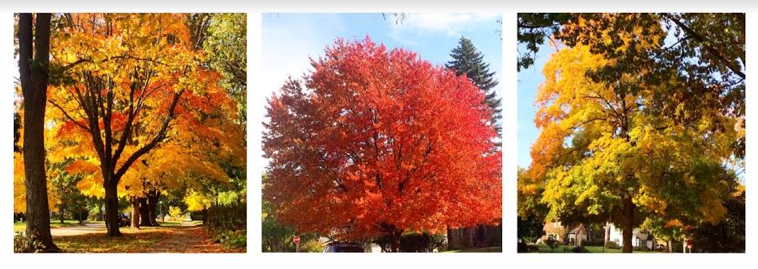
Finding distraction by photographing autumn beauty
Typically not a devoted sports fan, I found it a meaningful distraction to glue myself to the TV with family for the seventh game, cheering on the team from the city around whose edges I had lived for 32 years. Who would have thought I might stay up until 1 a.m. that night to see my team win, though by then I had left the TV to rely on my laptop for friends' input about the outcome! Taking in the hubbub of parades from a distance, witnessing the joy of a celebrating city, and seeing people I know making trips to Chicago to participate in the celebration over the following few days kept my attention from wandering back to the election. And finding this article, Why America needed the Cubs win, reminded me that it’s ok to be happy and hopeful in spite of what’s happening in the run-up to our election.
Beyond distraction, mindfulness techniques help “combat the negative political rhetoric of this contentious election,” according to author Susan Kaiser Greenland. She notes that “a collective effort to help each other lower our political anxiety is important for reasons that reach well beyond this election. When people feel anxious, they move into a reactive mode. Anxious people tend to be less flexible and less open to new experiences and points of view.”
This Patheos article recommends trying one or more of these 10 spiritual practices to survive toxic times: limiting media consumption (perhaps watching more HGTV or Food Network than usual?), reading poetry (see this Parker J. Palmer post which inspired the meme I placed at the top of this entry) or listening to music (try this version of The Prayer for starters), being generous, getting outside, being present, worshipping, praying, traveling, refusing to engage negativity, and doing something for someone else. You probably have other favorite remedies you might add to this list to overcome your anger and disappointment related to this election. I cook comfort food like mashed potatoes with mushroom gravy. And find inspiration wherever I can, usually starting with our kids and grandkids.
Come Tuesday night, you may wish to join Kern Roaders and folks from other area churches at the election day communion event explained below, where you can “pray for the transformation of the powers that rule our world to fulfill their calling to serve the common good, and gather with others around the table to remember Christ who first loved us and who we love and serve in return.” Reportedly, at least 200 of these gatherings will be held across the country.

And what of the day after, when many Americans will be disappointed with the outcome? Last night’s 60 Minutes segment suggested it will be the candidates’ responsibility to set the tone for accepting the outcome and moving on…to keep from breaking the thin thread that still binds us together in spite of our serious differences. Check out this article surfaced by Deanna from The Atlantic, Americans Don't Need Reconciliation—They Need to Get Better at Arguing. The author recommends more listening, more serving, more (constructive) arguing to arrive at reconciliation.
Add a commentOctober 31, 2016
By: Jane Bishop Halteman
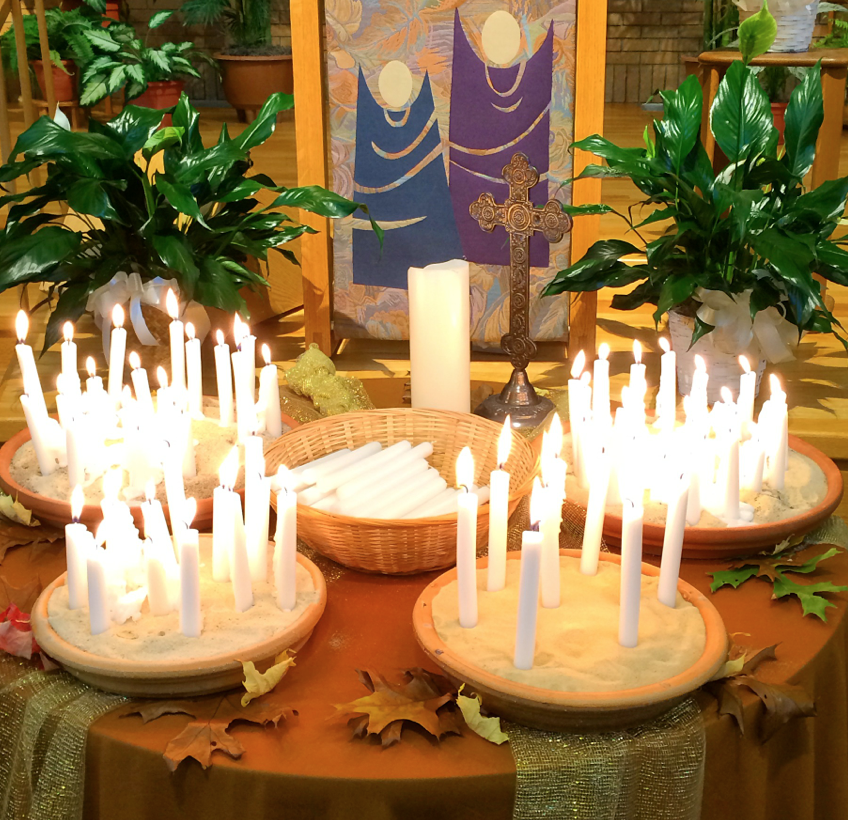
All Saints' Day candle-lighting ritual at Kern Road Sunday, October 30, 2016
How do you keep alive the memory of those lost to you, sometimes much too soon, sometimes after long, meaningful connections? When do you take time to recall those who have gone before you…perhaps on their birthdays or the days of their deaths? All Saints’ Day, observed on November 1 on the liturgical calendar of the church year, offers another occasion to reminisce about family and friends we have loved and lost.
Seven years ago a fortuitous meeting became the catalyst for me to take a closer look at losses dating back to my teens and twenties. A college mentor, upon learning that I was just beginning to excavate these ancient griefs, suggested the creation of a memorial by which to remember well.
Three years later, as the direct result of that conversation with my professor, my high school dedicated a memorial garden to remember all who died while students or later in life as alumni. During the dedication gathering, I spoke of the garden’s creation “as a place to remember family members and friends who have gone before us; as a place of quiet beauty where anyone may come for communion with the creator of all; as a place to participate in the process of life, from the greening of the shoot to the dying off of the flower; as a place to celebrate earth in all its majesty as God’s creation.”
My hopes for the garden were that it would remind those who visited that “God loves them and calls them perhaps to a new way of noticing God at work in their lives. I see the creation of this garden as a positive way to share our grief stories and to tend to our own griefs, so that we might maintain right relationship with ourselves, with the person we were when our loss took place, and with the person we have become in the process of suffering grief and loss.”
As I worked with others to prepare a worship service for that garden dedication, I came across the wisdom of folks like Elizabeth Lesser who writes about Good Grief in her book Broken Open. She says: “There is an art to grieving. To grieve well the loss of anyone or anything—a parent, a love, a child, an era, a home, a job, (one’s health)—is a creative act. It takes attention and patience and courage. But many of us do not know how to grieve. We were never taught, and we don’t see examples of full-bodied grieving around us. Our culture favors the fast-food model of mourning—get over it quickly and get back to work; affix the bandage of ‘closure’ and move on.
“Grief is a tonic,” according to Lesser. “It is a healing elixir, made of tears that lubricate the heart….When a friend or family member dies—or when the world loses one of its beloved citizens—we should not hold back our tears. Our tears, and the calm hands of grief that follow are not signs of some tragic and evil reality….Grief is the proof of our love, a demonstration of how deeply we have allowed another to touch us.”
Sometimes the words of others can serve as a healing elixir as well. John O’Donohue’s For Grief, a powerful recognition of the pain of loss, can be found at this link of daily mindfulness poetry. These words from Gates of Prayer, a Judaism Prayerbook, became another favorite reading of mine as I prepped for the garden dedication. Written for the arrival of the new millennium, the Spirituality and Practice website posts this piece as a reference to the power and the presence of the saints in our lives.
Back in 2005, I collected these words (surely a compilation of thoughts from a variety of resources I had been reading) to share as worship leader during the first All Saints’ Day worship observance in which I participated. I have not forgotten the power of them: We rejoice in the lives of those whom you have recently drawn into your eternal embrace, and we raise their families and friends into your strong arms of care and compassion in their continuing grief.
We thank you today for faithful people in every age who have looked to Jesus as teacher and role model. May we be strengthened by their witness and supported by their unseen presence from the balcony of heaven, that we may run with perseverance the race that lies before us, and, by faith, follow in the footsteps of so great a cloud of witnesses.
And now we join our voices with angels and archangels, with prophets, apostles, and martyrs, and with all the faithful of every time and place, who forever sing to the glory of your name, saying: Holy, holy, holy Lord, God of power and might, heaven and earth are full of your glory. Amen.
These many years later I remain transfixed by phrases like “balcony of heaven” and “cloud of witnesses” along with the idea of joining “our voices with angels and archangels” as I remember those I have loved and lost. In what ways do you remember those you have loved and lost? How do those memories nourish you? So that those who knew him would not forget him, I created this YouTube video of still shots of my youngest brother, who died when he was 18. This video depicts some of the scenes of the garden dedication at my high school four years ago.
Add a commentOctober 24, 2016
By: Jane Bishop Halteman
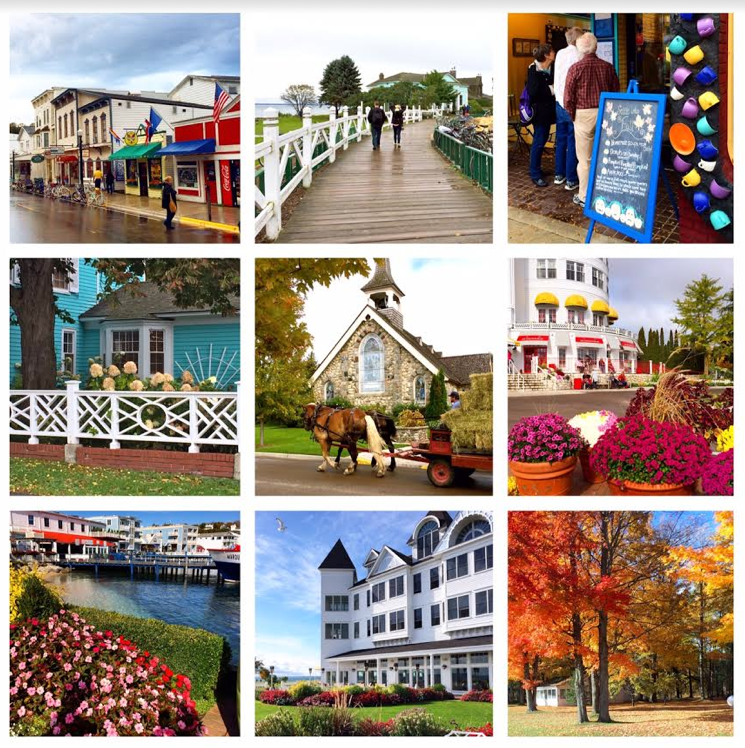
Every morning I receive a blessing by e-mail from the Dominican Sisters of Grand Rapids. Each one is exquisite, but Sunday’s blessing for Day 284 of 2016 spoke to me in a special way: “May our Creative God be with you, amazing you with the beauty of the Seasons, with the beauty of yourself. This is a day to pause and gaze about you and within you. Discover something new: Let your eyes 'notice', your taste buds 'savor', your hands 'embrace', your ears 'be attentive', your nose 'inhale' the wonders around you. Take time to thank your Body for speaking to you, for holding memories, for its healing powers, and for all parts working as one. In your own creative way, give Praise to the Creator of all good things.” (Sign up here to receive a daily blessing from the GR Dominicans.)
In the wake of a trip to Mackinac Island last week, where autumn had taken a firm grip and beauty reigned unabashedly though skies were grey, I had no trouble letting my eyes notice. The above photo collage documents some of the sights my traveling companions and I saw. Even in the slightly gloomy weather of the first day on the island, the bright buildings, glistening boardwalk, coffee shop, private homes, old stone church, and Grand Hotel glowed under dreary skies. The next day, as we were preparing to depart, sunshine heightened color in the harbor, the Iroquois Hotel, and the trees we passed on the drive home.
And it wasn’t difficult to bring back memories of the smell of fudge and caramel corn, the sound of horses clip-clopping around the island, the taste of margarita pizza, the feel of cool air blowing off the Straits of Mackinac connecting Lake Huron and Lake Michigan.
Before the Mackinac trip, I had stumbled across this Spirituality and Practice feature entitled Falling in Love with a Poem: How to develop a vibrant relationship with a poem, letting it change you. The subject matter, based on a book called Saved by a Poem: The Transformative Power of Words by Kim Rosen, drew my attention immediately and, as the week went by, I was reminded on two occasions of special quotes (though not complete poems) that had been favorites of mine for at least 20 years.
I spotted this long-loved quote from the Gerard Manley Hopkins poem God’s Grandeur on a friend’s social media page: “The world is charged with the grandeur of God; it will fan out, like shining from shook foil…” To be reminded of that quote while fall colors exploded around me (after having been nourished by it many times in the past) seemed a valuable synchronicity, especially as I thought of Rosen’s reference to poetry as “the language of the soul. From below the surface of your life, the truth of who you are calls to you through the poems you love. Even if you have been touched by only one poem, or just a single line heard at a crucial moment and remembered, those words are an invitation from within. To take them deeply into your life and speak them aloud brings every level of who you are—your thoughts, your words, your feelings, and even your physical energies—into alignment with what matters most to you. You are receiving and giving voice not only to the poem but also to your own soul.”
A second favorite quote, this one from Frederick Buechner’s Wishful Thinking: A Theological ABC, came to mind in a phone conversation when a friend referenced it: “The place God calls you to is the place where your deep gladness and the world’s deep hunger meet.” I couldn’t help but remember back to the day when I first read that Buechner quote and realized my deep gladness and the world’s deep hunger were calling me, over weeks, months, and even years, to become a spiritual director.
Recalling once again the Buechner quote drew me to this paragraph in the Rosen book: “As you go deeper into your relationship with a poem, it may guide you to discover treasures that you did not know you had. Perhaps there are hidden talents or creative visions that will appear. Perhaps the poem will call forth a long-buried memory, magnetized by the words to the surface of your consciousness for healing or inspiration. Perhaps it will open you to a new way of seeing the world, or a feeling of grief you have avoided, or an experience of joy you didn't know was in you.”
The Dominican blessing highlights the very things we might learn from befriending a poem: “This is a day to pause and gaze about you and within you. Discover something new.”
Has a poem ever led you to a sacred space? If so, you already know the benefits of befriending a poem. If not, perhaps you will choose “to take a poem you love into your heart and your body.”
The Spirituality and Practice article recommends that “once you have your poem, one that seems to you to be shimmering with inspiration, write it out by hand if possible (to make it more personal) or create a printed copy. In quiet times or during your daily activities, bring out your poem and savor it one line or stanza at a time. Over the course of weeks, you will come to know it so well that parts of it arise in your heart on the spur of the moment like words of scripture, to guide and comfort you.”
May the Dominican blessing lead you this day and week, as well, to "let your eyes 'notice', your taste buds 'savor', your hands 'embrace', your ears 'be attentive', your nose 'inhale' the wonders around you."
Add a comment
October 17, 2016
By: Jane Bishop Halteman
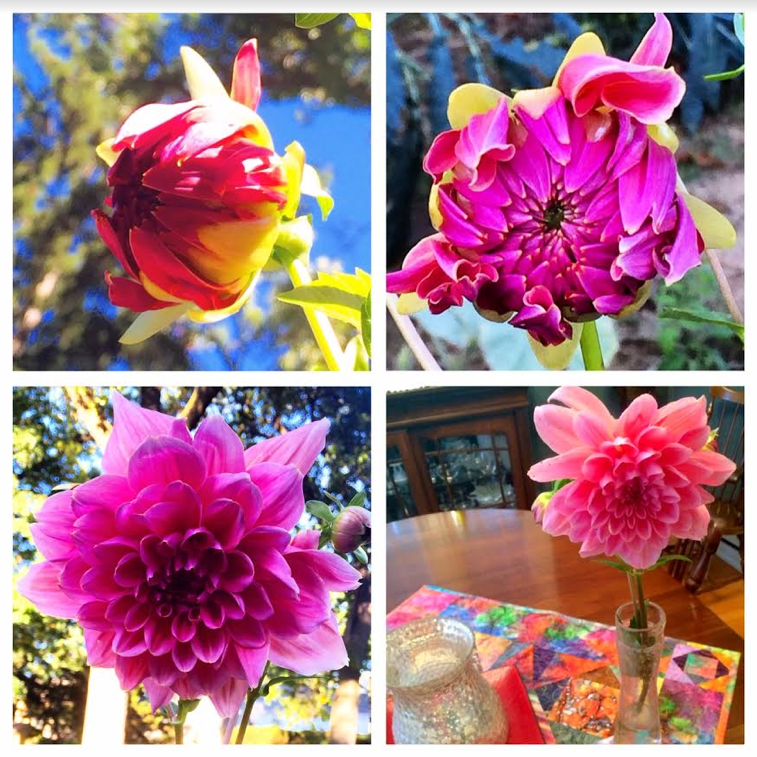
And the blog rolls on, from bud to bloom
Last week’s Glimpses of Healing and Hope blog post, Passing it on, appeared as #52 in a full year’s cycle of stories and photos I shared after an invitation during the spring of 2015 from congregational leaders to craft “weekly stories of healing and hope, of grace, joy, and peace, of how we might continue to practice being a faithful community, opening ourselves to God to turn our hearts and words into actions that will make a difference in our world.”
Today’s post reviews that year of entries, considering what themes emerged and what influences prevailed as subjects came to the foreground, some on one occasion, others more than once. Hyperlinks to many of these posts can be found below or at Kern Road’s blog archive or at this Pinterest board, where each also is identified by an accompanying photo.
Little did we know 12 months ago that the US would be embroiled a year later in what feels like an all-out war on the political scene (see this NPR story for election stress report). Though news events are not the stuff of which these posts are made, I discovered on looking back that the fall-out of national or international anxiety often resides somewhere behind an entry…as an example see this Resurrection season story which opened with a reference to a sharing by Loren one Sunday during worship.
Like Loren’s story, nearly a quarter of the blog posts created in the last year sourced directly from the Kern Road community. We discovered the backstory to Danile and Nancy’s musical collaboration; what the congregation’s Longest Night service is all about; how Lindy, Deanna, Nancy, and I made our word for the year picks. We learned about Leonard and Eunice’s interest in bringing family to the US, Elaine and Cathy’s involvement in the Near Northwest Neighborhood, how the western area group welcomed a new family to their community. Other blog posts detailed brief bios of some of the KRMC women featured in The Gifts of Women, spoke of our annual lawn service, shared about our service of lament following a tragic week, and further elaborated on area group and small group activity in the congregation.
A number of posts brought faith practices to the fore in an effort to counteract the dissonance of what’s going on in our everyday lives, whether that dissonance comes from the news or our jobs or our lives on the home front. In addition to focusing on enthusiasm, beauty, and silence as worthwhile spiritual disciplines, blog posts also highlighted photography, joy and delight in our town, self-nurture, breathing at high altitude, resurrection living, blessing one another, care of the earth, and finding sanctuary as useful tools on the faith journey.
Because I am a contemplative and that way of being is how I most often view the world, offerings typically revealed that perspective. In addition to the very first Glimpses of Healing and Hope post about the nurturing Saint Joe River which meanders through South Bend, the blog touched on harnessing old memories, spoke of finding the Divine in the storms of life, and revealed ways in which the seasons inform our faith journeys, here in spring, here in fall.
Loosely organized around the church year, blog posts featured subjects including All Saints’ Day, Advent and Christmas, Holy Week, Easter and Eastertide, and Pentecost. Days of the secular calendar, like the start of the new year, Martin Luther King Day, and Earth Day, stirred other posts into being. And some posts were driven by connections to the larger church, including this MEDA story, another about the area relief sale and MCC, and this one on a Lutheran apology to local Anabaptists.
Occasionally blog posts took root in worship services, this one as the result of a sermon at the retirement community where my parents live, and this one grounded in a KRMC service during which we sang a song that mentioned small paper lanterns.
Sometimes, as sources of inspiration, I turned to books I was reading (like Barbara Brown Taylor’s Learning to Walk in the Dark) or great art (to reflect on Ash Wednesday by looking at Bruegel’s Carnival and Lent or amplify Lenten learnings with a reference to Rembrandt’s Prodigal Son).
Clearly this year's travels, frequent visits with my aging parents, and turning 70 this past summer also have influenced what’s on my mind as I share glimpses of healing and hope. Entries garnering the greatest number of hits this year included Best Gifts Ever at just over 1,200 and Danile and Nancy’s story, referenced above, at nearly 1,170. I have no idea who those readers are, for the most part, but I am grateful.
Many thanks to writers who continue to inspire my own musings, including Parker Palmer, Frederic and Mary Ann Brussat at Spirituality and Practice, Jan Richardson, John O’Donohue, Krista Tippett, Mary Oliver, David Whyte, and many others, as well as social media friends who keep beaming my way hopeful thoughts, encouraging reminders and admonitions, and positive insights to light the way on the faith journey.
The one thing I would love to see increase as this blog moves forward into its second year is interaction with readers. I hope you will subscribe at the website or check the KRMC Facebook page or mine to stay connected. And please feel free to submit your personal glimpses of healing and hope for sharing in future entries.
Add a comment
October 10, 2016
By: Jane Bishop Halteman

My Aunt Ruthie gave me a tuber last spring which produced the beautiful pink dahlia above. Knowing that dahlias require special handling, like being dug up each fall and replanted after all danger of frost is past in the spring, I had never tried my hand at raising them.
My aunt hoped that at least one of the two varieties she brought me (of the four kinds she plants) had come from my grandmother’s property many years earlier, so I was eager to grow these dahlias. We stored them over the winter and put them in the ground after the last frost. The leaves came quickly on one tuber, but the other, which had seemed by planting time lighter in weight and somewhat withered, never produced green shoots.
Still, I was excited to see whether the pink or red variety had survived and what the flower would look like. I waited for buds all summer and into fall and, finally, several weeks ago, I noticed that tiny buds had begun to plump up. Earlier this week, one of the tight buds unfurled enough to catch a glimpse of pink, but the day-to-day unfolding has been painfully slow.
My aunt is not on Facebook, but her daughters are, and they kindly have shown her the first bloom’s daily progress as posted on my Facebook page. Saturday the news came from my aunt by e-mail that the surviving dahlia likely is not one originally raised by my grandmother in southeastern Pennsylvania, so we will try again to find a way to get some of Grammy's tubers to Indiana. Sunday I learned, based on my aunt's scrutiny of the above photo, that the dahlia is from a neighbor's daughter and bears the name Otto's Thrill. Back at our home in the Chicago suburbs, we had many plants which had been transplanted from my grandmother's huge collection of flowers. None of them, unfortunately, came with us to South Bend and I have missed them in our gardens here.
Why do I take joy in the possibility of growing flowers that belonged to my grandmother and have been passed on to me by her daughter, my mother's youngest sister? This aunt, always special to me, still lived at home with her parents when I was born. As I grew up, I remember her showing me her wallet, full of photos of high school friends. Some years later, I recall writing letters to her with white ink on red stationery after she married and moved out of town. I proudly held her firstborn when my family paid her and my uncle a visit. And I vividly recall the horror of her losing her youngest child the day her oldest child was married, a tragedy too huge to imagine, but one that I resonated with deeply as I also had experienced loss by that point in my life.
Beyond appreciating Aunt Ruthie as the giver of these flowers, as I appreciate all my family, I love surrounding myself with connections that become daily reminders of the generations that preceded mine, particularly because I moved away from the part of the country where I was born and, since college, have not had the routine opportunity to spend time with my family of origin.
But I feel in touch with family every time I sit on the reupholstered couch dating back to my parents' early marriage days, as I light the candles on the gate-leg table from my great-grandparents, as I eat from my mom and dad's wedding china, made in occupied Japan. The memories of Grammy's Christmas dinners flood back when I use the server from her dining room, which now resides in mine. I think of my mother's family when I spend time in our guest room, occupied by an oak bedroom suite from my grandparents' farmhouse, or when I admire the secretary in our living room bought by my parents at a great uncle's sale.
A rocking chair from Jim's family, now located in our sunroom, and the small caned chairs scattered around the house bring back memories of his parents and the generations that went before them. I am pleased to live with reminders from both sides of our families; so many are no longer with us, but we remember them well for having passed down their faith to our generation. As we approach All Saints' Day at the start of next month, I look forward to recalling, between now and then, the many ways in which that great cloud of family witnesses continues to surround us from the balcony of heaven!
What reminders of your family of faith surround you? Do physical reminders, like flowers and the belongings of earlier generations, help keep family connections alive for you? How do you stay connected to those who have gone before? What have they passed on to you for which you are grateful? What do you hope to pass on to the next generation?
Add a commentOctober 3, 2016
By: Jane Bishop Halteman
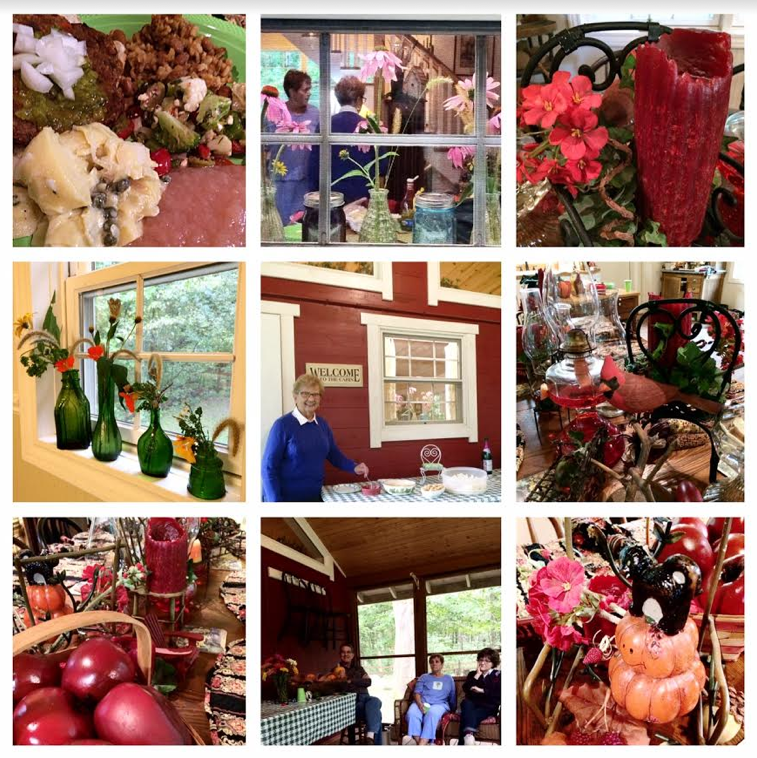
Complete sensory experience: small group treats five senses to restoration
Reading a Slate article this week about election anxiety (bearing the subhead “Therapists and their patients are struggling to cope amid the national nervous breakdown that is the 2016 election”) made me realize that now, more than ever, we all need ways to relax and walk away from the chaos, even if just for a short time.
How we choose to find rainbows in the midst of the storm probably depends on our personal inclinations and interests. Here’s what came to my attention this week. From Parker Palmer: “Every morning—after reading the news from the human world and becoming a bit disheartened—I visit Nature 365 at http://nature365.tv.
“There, I find a brief video that takes me to the Boundary Waters of northern Minnesota—or to the prairie of southwestern Minnesota—unspoiled natural places that I love.
“I watch the video, expertly filmed by one of the world’s most celebrated nature photographers. Then I say to myself, ‘This, too, is happening in our world today...’
“I come away reminded that there is beauty as well as ugliness in our world, light as well as dark, and I start the day better able to see life steadily and see it whole...”
Lisa Scandrette, a contributing writer to the blog Godspace’s September Creative Prayer Theme, offers this in her September 28 post: “When I begin to feel anxious about the events of life, I take out my knitting. The yarn, warm and soft, glides through my hands, rhythmically making one loop after another. I may not be able to solve my daughter’s health puzzle or take away a friend’s tragedy, but I can make loop after loop after loop. As I do, my shoulders relax, my breathing slows, my mind slows down. My love and prayers flow from my heart, down my arms, out my knitting needles and into the fabric. Sometimes I need this process over and over and over.”
Back in July, Ten Thousand Villages’ blog site Mosaic offered a post entitled 3 Simple Ways to Reach Relaxation. According to the article, “You can create a retreat for yourself in nearly any environment by using any combination of these three techniques for relaxation: complete sensory experience, mindfulness, embracing even the smallest pleasures.”
Suggesting that setting up a location where all five senses—sight, sound, taste, touch, and smell—can be awakened is an easy place to begin, the post recommends creating a complete sensory experience by surrounding one’s self with art, subtle sound like wind chimes, an enjoyable drink, the pleasant touch of something nearby, and fragrant growing things.
“Take your senses a step farther and promote each one of them with a mindful activity,” the article advises, and finally “put a positive spin on everyday experiences” like setting a table by starting “with a nice tablecloth, even for simple meals…even for takeout.”
Our small group potluck picnic Sunday night, the first event since we took a summer break some months ago, felt like a respite from the storm, a reconnecting with people we care about, people who care about us. (See collage above for sight samples…you can imagine the remainder based on these!) In the beautiful surroundings created by hostess Marceil, nature-loving host Don shared about the personal restoration the outdoors brings him, then invited us to share how we experience creation as a place of respite. We named the night sky filled with stars, the daytime sky with cloud formations, water, flowers, trees, birds, and animals as restorative parts of our everyday lives.
This blog post at Voice and Vessel, A Writing Studio, is entitled Four Autumn Rituals to Fire Up Your Creative Spirit. Intended to help writers center themselves as they enter a new season, I couldn’t help but think these pointers also might benefit the rest of us as we seek ways to relax by “recentering creative intentions, trying a new soundtrack, using changing colors to tune attention, falling for some new poetry.”
This video of a children’s choir singing Shenandoah warmed my heart this week, after I found a link to it in The Mennonite. Check it out if you are weary, distracted, anxious. What other prayer practices or spiritual disciplines refresh you when you need a change of pace or scenery? How do you meet the Divine in the midst of the chaos life brings?
I can quickly lose myself in a painting like this one, Peter Paul Rubens’ The Landscape Rainbow, as discussed by Spirituality and Practice here, or walking a labyrinth or sitting with an icon. May you find a place of rest and relaxation with the Divine as you journey in the coming week.
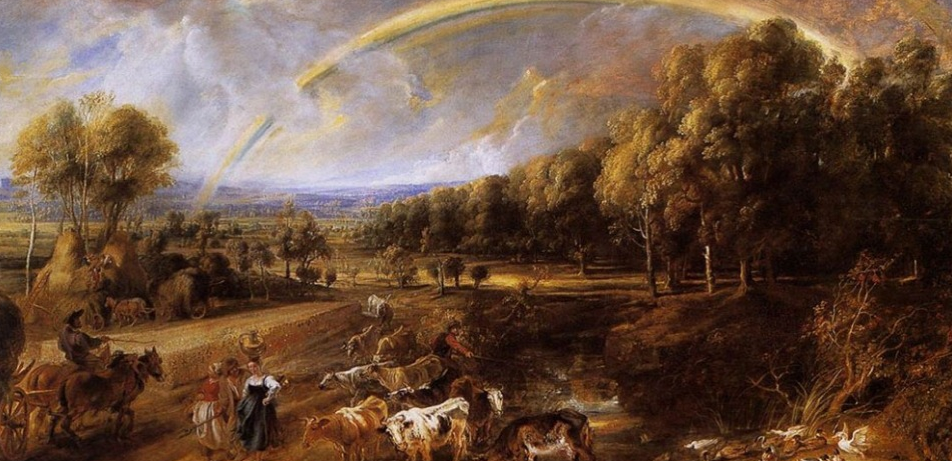
Peter Paul Rubens' The Landscape Rainbow
Add a comment
